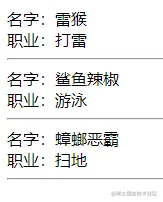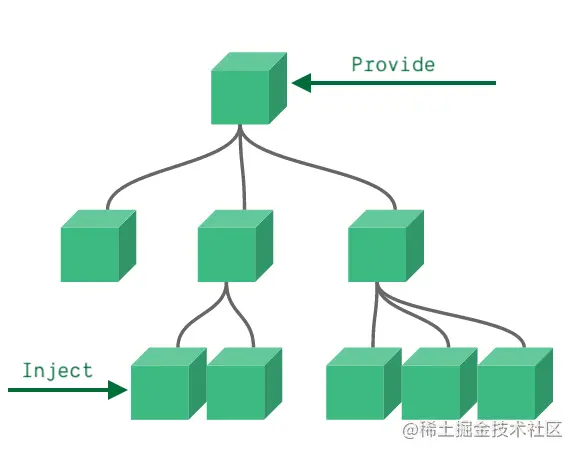Vue组件间怎么通讯?下面本篇文章给大家分享十多种Vue3组件通讯方式,希望对大家有所帮助!

本文讲解
Vue 3.2组件多种通讯方式的基础用法,并且使用了单文件组件 5101c0cdbdc49998c642c71f6b6410a8。
众所周知,Vue.js 中一个很重要的知识点是组件通信,不管是业务类的开发还是组件库开发,都有各自的通讯方法。【相关推荐:vuejs视频教程】
本文适合:
有
Vue 3基础的读者。打算开发组件库的读者。
本文会涉及的知识点:
Props
emits
expose / ref
Non-Props
v-model
插槽 slot
provide / inject
总线 bus
getCurrentInstance
Vuex
Pinia
mitt.js
我会将上面罗列的知识点都写一个简单的 demo。本文的目的是让大家知道有这些方法可以用,所以并不会深挖每个知识点。
建议读者跟着本文敲一遍代码,然后根据本文给出的链接去深挖各个知识点。
收藏(学到)是自己的!
Props
父组件传值给子组件(简称:父传子)
Props 文档
https://v3.cn.vuejs.org/guide/component-props.html
父组件
// Parent.vue <template> <!-- 使用子组件 --> <Child :msg="message" /> </template> <script setup> import Child from './components/Child.vue' // 引入子组件 let message = '雷猴' </script>
子组件
// Child.vue
<template>
<div>
{{ msg }}
</div>
</template>
<script setup>
const props = defineProps({
msg: {
type: String,
default: ''
}
})
console.log(props.msg) // 在 js 里需要使用 props.xxx 的方式使用。在 html 中使用不需要 props
</script>在 5101c0cdbdc49998c642c71f6b6410a8 中必须使用 defineProps API 来声明 props,它具备完整的推断并且在 5101c0cdbdc49998c642c71f6b6410a8 中是直接可用的。
更多细节请看 文档。
https://v3.cn.vuejs.org/api/sfc-script-setup.html#defineprops-%E5%92%8C-defineemits
在 5101c0cdbdc49998c642c71f6b6410a8 中,defineProps 不需要另外引入。
props 其实还能做很多事情,比如:设置默认值 default ,类型验证 type ,要求必传 required ,自定义验证函数 validator 等等。
大家可以去官网看看,这是必须掌握的知识点!
props 文档
https://v3.cn.vuejs.org/guide/component-props.html
emits
子组件通知父组件触发一个事件,并且可以传值给父组件。(简称:子传父)
emits 文档
https://v3.cn.vuejs.org/guide/migration/emits-option.html

父组件
// Parent.vue
<template>
<div>父组件:{{ message }}</div>
<!-- 自定义 changeMsg 事件 -->
<Child @changeMsg="changeMessage" />
</template>
<script setup>
import { ref } from 'vue'
import Child from './components/Child.vue'
let message = ref('雷猴')
// 更改 message 的值,data是从子组件传过来的
function changeMessage(data) {
message.value = data
}
</script>子组件
// Child.vue
<template>
<div>
子组件:<button @click="handleClick">子组件的按钮</button>
</div>
</template>
<script setup>
// 注册一个自定义事件名,向上传递时告诉父组件要触发的事件。
const emit = defineEmits(['changeMsg'])
function handleClick() {
// 参数1:事件名
// 参数2:传给父组件的值
emit('changeMsg', '鲨鱼辣椒')
}
</script>和 props 一样,在 5101c0cdbdc49998c642c71f6b6410a8 中必须使用 defineEmits API 来声明 emits,它具备完整的推断并且在 5101c0cdbdc49998c642c71f6b6410a8 中是直接可用的。
更多细节请看 文档。
https://v3.cn.vuejs.org/api/sfc-script-setup.html#defineprops-%E5%92%8C-defineemits
在 5101c0cdbdc49998c642c71f6b6410a8 中,defineEmits 不需要另外引入。
expose / ref
子组件可以通过 expose 暴露自身的方法和数据。
父组件通过 ref 获取到子组件并调用其方法或访问数据。
expose 文档
https://v3.cn.vuejs.org/api/options-data.html#expose
用例子说话

父组件
// Parent.vue
<template>
<div>父组件:拿到子组件的message数据:{{ msg }}</div>
<button @click="callChildFn">调用子组件的方法</button>
<hr>
<Child ref="com" />
</template>
<script setup>
import { ref, onMounted } from 'vue'
import Child from './components/Child.vue'
const com = ref(null) // 通过 模板ref 绑定子组件
const msg = ref('')
onMounted(() => {
// 在加载完成后,将子组件的 message 赋值给 msg
msg.value = com.value.message
})
function callChildFn() {
// 调用子组件的 changeMessage 方法
com.value.changeMessage('蒜头王八')
// 重新将 子组件的message 赋值给 msg
msg.value = com.value.message
}
</script>子组件
// Child.vue
<template>
<div>子组件:{{ message }}</div>
</template>
<script setup>
import { ref } from 'vue'
const message = ref('蟑螂恶霸')
function changeMessage(data) {
message.value = data
}
使用 defineExpose 向外暴露指定的数据和方法
defineExpose({
message,
changeMessage
})
</script>在 5101c0cdbdc49998c642c71f6b6410a8 中,defineExpose 不需要另外引入。
expose 文档
https://v3.cn.vuejs.org/api/options-data.html#expose
defineExpose 文档
https://v3.cn.vuejs.org/api/sfc-script-setup.html#defineexpose
Non-Props
所谓的 Non-Props 就是 非 Prop 的 Attribute。
意思是在子组件中,没使用 prop 或 emits 定义的 attribute,可以通过 $attrs 来访问。
常见的有 class 、style 和 id。
还是举个例子会直观点
单个根元素的情况
父组件
// Parent.vue
<template>
<Child msg="雷猴 世界!" name="鲨鱼辣椒" />
</template>
<script setup>
import { ref } from 'vue'
import Child from './components/Child.vue'
</script>子组件
// Child.vue <template> <div>子组件:打开控制台看看</div> </template>

打开控制台可以看到,属性被挂到 HTML 元素上了。
多个元素的情况
但在 Vue3 中,组件已经没规定只能有一个根元素了。如果子组件是多个元素时,上面的例子就不生效了。
// Child.vue <template> <div>子组件:打开控制台看看</div> <div>子组件:打开控制台看看</div> </template>

此时可以使用 $attrs 的方式进行绑定。
// Child.vue <template> <div :message="$attrs.msg">只绑定指定值</div> <div v-bind="$attrs">全绑定</div> </template>

v-model
v-model 是 Vue 的一个语法糖。在 Vue3 中的玩法就更多(晕)了。
单值的情况
组件上的 v-model 使用 modelValue 作为 prop 和 update:modelValue 作为事件。
v-model 参数文档
https://v3.cn.vuejs.org/guide/component-custom-events.html#v-model-%E5%8F%82%E6%95%B0
父组件
// Parent.vue
<template>
<Child v-model="message" />
</template>
<script setup>
import { ref } from 'vue'
import Child from './components/Child.vue'
const message = ref('雷猴')
</script>子组件
// Child.vue
<template>
<div @click="handleClick">{{modelValue}}</div>
</template>
<script setup>
import { ref } from 'vue'
// 接收
const props = defineProps([
'modelValue' // 接收父组件使用 v-model 传进来的值,必须用 modelValue 这个名字来接收
])
const emit = defineEmits(['update:modelValue']) // 必须用 update:modelValue 这个名字来通知父组件修改值
function handleClick() {
// 参数1:通知父组件修改值的方法名
// 参数2:要修改的值
emit('update:modelValue', '喷射河马')
}
</script>
你也可以这样写,更加简单
子组件
// Child.vue
<template>
<div @click="$emit('update:modelValue', '喷射河马')">{{modelValue}}</div>
</template>
<script setup>
import { ref } from 'vue'
// 接收
const props = defineProps([
'modelValue' // 接收父组件使用 v-model 传进来的值,必须用 modelValue 这个名字来接收
])
</script>多个 v-model 绑定
多个 v-model 绑定 文档
https://v3.cn.vuejs.org/guide/component-custom-events.html#%E5%A4%9A%E4%B8%AA-v-model-%E7%BB%91%E5%AE%9A
父组件
// Parent.vue
<template>
<Child v-model:msg1="message1" v-model:msg2="message2" />
</template>
<script setup>
import { ref } from 'vue'
import Child from './components/Child.vue'
const message1 = ref('雷猴')
const message2 = ref('蟑螂恶霸')
</script>子组件
// Child.vue
<template>
<div><button @click="changeMsg1">修改msg1</button> {{msg1}}</div>
<div><button @click="changeMsg2">修改msg2</button> {{msg2}}</div>
</template>
<script setup>
import { ref } from 'vue'
// 接收
const props = defineProps({
msg1: String,
msg2: String
})
const emit = defineEmits(['update:msg1', 'update:msg2'])
function changeMsg1() {
emit('update:msg1', '鲨鱼辣椒')
}
function changeMsg2() {
emit('update:msg2', '蝎子莱莱')
}
</script>
v-model 修饰符
v-model 还能通过 . 的方式传入修饰。
v-model 修饰符 文档
https://v3.cn.vuejs.org/guide/component-custom-events.html#%E5%A4%84%E7%90%86-v-model-%E4%BF%AE%E9%A5%B0%E7%AC%A6
父组件
// Parent.vue
<template>
<Child v-model.uppercase="message" />
</template>
<script setup>
import { ref } from 'vue'
import Child from './components/Child.vue'
const message = ref('hello')
</script>子组件
// Child.vue
<template>
<div>{{modelValue}}</div>
</template>
<script setup>
import { ref, onMounted } from 'vue'
const props = defineProps([
'modelValue',
'modelModifiers'
])
const emit = defineEmits(['update:modelValue'])
onMounted(() => {
// 判断有没有 uppercase 修饰符,有的话就执行 toUpperCase() 方法
if (props.modelModifiers.uppercase) {
emit('update:modelValue', props.modelValue.toUpperCase())
}
})
</script>
插槽 slot
插槽可以理解为传一段 HTML 片段给子组件。子组件将 58cb293b8600657fad49ec2c8d37b472 元素作为承载分发内容的出口。
插槽 文档
https://v3.cn.vuejs.org/guide/component-slots.html
本文打算讲讲日常用得比较多的3种插槽:默认插槽、具名插槽、作用域插槽。
默认插槽
插槽的基础用法非常简单,只需在 子组件 中使用 58cb293b8600657fad49ec2c8d37b472 标签,就会将父组件传进来的 HTML 内容渲染出来。
默认插槽 文档
https://v3.cn.vuejs.org/guide/component-slots.html#%E6%8F%92%E6%A7%BD%E5%86%85%E5%AE%B9
父组件
// Parent.vue
<template>
<Child>
<div>雷猴啊</div>
</Child>
</template>子组件
// Child.vue
<template>
<div>
<slot></slot>
</div>
</template>具名插槽
具名插槽 就是在 默认插槽 的基础上进行分类,可以理解为对号入座。
具名插槽 文档
https://v3.cn.vuejs.org/guide/component-slots.html#%E5%85%B7%E5%90%8D%E6%8F%92%E6%A7%BD

父组件
// Parent.vue
<template>
<Child>
<template v-slot:monkey>
<div>雷猴啊</div>
</template>
<button>鲨鱼辣椒</button>
</Child>
</template>子组件
// Child.vue
<template>
<div>
<!-- 默认插槽 -->
<slot></slot>
<!-- 具名插槽 -->
<slot name="monkey"></slot>
</div>
</template>父组件需要使用 d477f9ce7bf77f53fbcf36bec1b69b7a 标签,并在标签上使用 v-solt: + 名称 。
子组件需要在 58cb293b8600657fad49ec2c8d37b472 标签里用 name= 名称 对应接收。
这就是 对号入座。
最后需要注意的是,插槽内容的排版顺序,是 以子组件里的排版为准。
上面这个例子就是这样,你可以仔细观察子组件传入顺序和子组件的排版顺序。
作用域插槽
如果你用过 Element-Plus 这类 UI框架 的 Table ,应该就能很好的理解什么叫作用域插槽。
作用域插槽 文档
https://v3.cn.vuejs.org/guide/component-slots.html#%E4%BD%9C%E7%94%A8%E5%9F%9F%E6%8F%92%E6%A7%BD

父组件
// Parent.vue
<template>
<!-- v-slot="{scope}" 获取子组件传上来的数据 -->
<!-- :list="list" 把list传给子组件 -->
<Child v-slot="{scope}" :list="list">
<div>
<div>名字:{{ scope.name }}</div>
<div>职业:{{ scope.occupation }}</div>
<hr>
</div>
</Child>
</template>
<script setup>
import { ref } from 'vue'
import Child from './components/Child.vue'
const list = ref([
{ name: '雷猴', occupation: '打雷'},
{ name: '鲨鱼辣椒', occupation: '游泳'},
{ name: '蟑螂恶霸', occupation: '扫地'},
])
</script>子组件
// Child.vue
<template>
<div>
<!-- 用 :scope="item" 返回每一项 -->
<slot v-for="item in list" :scope="item" />
</div>
</template>
<script setup>
const props = defineProps({
list: {
type: Array,
default: () => []
}
})
</script>我没写样式,所以用 hr 元素让视觉上看上去比较清晰我就是懒。
provide / inject
遇到多层传值时,使用 props 和 emit 的方式会显得比较笨拙。这时就可以用 provide 和 inject 了。
provide 是在父组件里使用的,可以往下传值。
inject 是在子(后代)组件里使用的,可以网上取值。
无论组件层次结构有多深,父组件都可以作为其所有子组件的依赖提供者。
provide / inject 文档
https://v3.cn.vuejs.org/guide/component-provide-inject.html

父组件
// Parent.vue
<template>
<Child></Child>
</template>
<script setup>
import { ref, provide, readonly } from 'vue'
import Child from './components/Child.vue'
const name = ref('猛虎下山')
const msg = ref('雷猴')
// 使用readonly可以让子组件无法直接修改,需要调用provide往下传的方法来修改
provide('name', readonly(name))
provide('msg', msg)
provide('changeName', (value) => {
name.value = value
})
</script>子组件
// Child.vue
<template>
<div>
<div>msg: {{ msg }}</div>
<div>name: {{name}}</div>
<button @click="handleClick">修改</button>
</div>
</template>
<script setup>
import { inject } from 'vue'
const name = inject('name', 'hello') // 看看有没有值,没值的话就适用默认值(这里默认值是hello)
const msg = inject('msg')
const changeName = inject('changeName')
function handleClick() {
// 这样写不合适,因为vue里推荐使用单向数据流,当父级使用readonly后,这行代码是不会生效的。没使用之前才会生效。
// name.value = '雷猴'
// 正确的方式
changeName('虎躯一震')
// 因为 msg 没被 readonly 过,所以可以直接修改值
msg.value = '世界'
}
</script>provide 可以配合 readonly 一起使用,详情可以看上面例子和注释。
provide 和 inject 其实主要是用在深层关系中传值,上面的例子只有父子2层,只是为了举例说明我懒。
总线 bus
在 Vue2 有总线传值的方法,我们在 Vue3 中也可以自己模拟。
这个方式其实有点像 Vuex 或者 Pinia 那样,弄一个独立的工具出来专门控制数据。
但和 Vuex 或 Pinia 相比,我们自己写的这个方法并没有很好的数据跟踪之类的特性。
原理
我们创建一个 Bus.js 文件,用来控制数据和注册事件的。
Bus.js 里有一个 Bus 类
-
eventList是必须项,用来存放事件列表的。 -
constructor里除了eventList外,其他都是自定义数据,公共数据就是存在这里的。 -
$on方法用来注册事件。 -
$emit方法可以调用$on里的事件。 -
$off方法可以注销eventList里的事件。
然后需要用到总线的组件,都导入 Bus.js ,就可以共同操作一份数据了。
Bus.js
import { ref } from 'vue'
class Bus {
constructor() {
// 收集订阅信息,调度中心
this.eventList = {}, // 事件列表,这项是必须的
// 下面的都是自定义值
this.msg = ref('这是一条总线的信息')
}
// 订阅
$on(name, fn) {
this.eventList[name] = this.eventList[name] || []
this.eventList[name].push(fn)
}
// 发布
$emit(name, data) {
if (this.eventList[name]) {
this.eventList[name].forEach((fn) => {
fn(data)
});
}
}
// 取消订阅
$off(name) {
if (this.eventList[name]) {
delete this.eventList[name]
}
}
}
export default new Bus()父组件
// Parent.vue
<template>
<div>
父组件:
<span style="margin-right: 30px;">message: {{ message }}</span>
<span>msg: {{ msg }}</span>
</div>
<Child></Child>
</template>
<script setup>
import { ref } from 'vue'
import Bus from './Bus.js'
import Child from './components/Child.vue'
const msg = ref(Bus.msg)
const message = ref('hello')
// 用监听的写法
Bus.$on('changeMsg', data => {
message.value = data
})
</script>子组件
// Child.vue
<template>
<div>
子组件:
<button @click="handleBusEmit">触发Bus.$emit</button>
<button @click="changeBusMsg">修改总线里的 msg</button>
</div>
</template>
<script setup>
import Bus from '../Bus.js'
function handleBusEmit() {
Bus.$emit('changeMsg', '雷猴啊')
}
function changeBusMsg() {
// console.log(Bus.msg)
Bus.msg.value = '在子组件里修改了总线的值'
}
</script>这个方法其实还挺好用的,但光看可能有点懵,请大家务必亲手敲一下代码实践一下。
getCurrentInstance
getcurrentinstance 是 vue 提供的一个方法,支持访问内部组件实例。
getCurrentInstance只暴露给高阶使用场景,典型的比如在库中。强烈反对在应用的代码中使用getCurrentInstance。请不要把它当作在组合式 API 中获取this的替代方案来使用。
说白了,这个方法 适合在开发组件库的情况下使用,不适合日常业务开发中使用。
getCurrentInstance 只能在 setup 或生命周期钩子中调用。
getcurrentinstance 文档
https://v3.cn.vuejs.org/api/composition-api.html#getcurrentinstance
在 5101c0cdbdc49998c642c71f6b6410a8 中,我模拟了类似 $parent 和 $children 的方式。
父组件
// Parent.vue
<template>
<div>父组件 message 的值: {{ message }}</div>
<button @click="handleClick">获取子组件</button>
<Child></Child>
<Child></Child>
</template>
<script setup>
import { ref, getCurrentInstance, onMounted } from 'vue'
import Child from './components/Child.vue'
const message = ref('雷猴啊')
let instance = null
onMounted(() => {
instance = getCurrentInstance()
})
// 子组件列表
let childrenList = []
// 注册组件
function registrationCom(com) {
childrenList.push(com)
}
function handleClick() {
if (childrenList.length > 0) {
childrenList.forEach(item => {
console.log('组件实例:', item)
console.log('组件名(name):', item.type.name)
console.log('组件输入框的值:', item.devtoolsRawSetupState.inputValue)
console.log('---------------------------------------')
})
}
}
</script>子组件
// Child.vue
<template>
<div>
<div>----------------------------</div>
子组件:<button @click="handleClick">获取父组件的值</button>
<br>
<input type="text" v-model="inputValue">
</div>
</template>
<script>
export default {
name: 'ccccc'
}
</script>
<script setup>
import { getCurrentInstance, onMounted, nextTick, ref } from 'vue'
const inputValue = ref('')
let instance = null
onMounted(() => {
instance = getCurrentInstance()
nextTick(() => {
instance.parent.devtoolsRawSetupState.registrationCom(instance)
})
})
function handleClick() {
let msg = instance.parent.devtoolsRawSetupState.message
msg.value = '哈哈哈哈哈哈'
}
</script>可以将代码复制到你的项目中运行试试看,最好还是敲一遍咯。
Vuex
Vuex 主要解决 跨组件通信 的问题。
在 Vue3 中,需要使用 Vuex v4.x 版本。
安装
用 npm 或者 Yarn 安装到项目中。
npm install vuex@next --save # 或 yarn add vuex@next --save
使用
安装成功后,在 src 目录下创建 store 目录,再在 store 下创建 index.js 文件。
// store/index.js
import { createStore } from 'vuex'
export default createStore({
state: {
},
getters: {
},
mutations: {
},
actions: {
},
modules: {
}
})在 store/index.js 下输入以上内容。
-
state:数据仓库,用来存数据的。 -
getters:获取数据的,有点像computed的用法(个人觉得)。 -
mutations: 更改state数据的方法都要写在mutations里。 -
actions:异步异步异步,异步的方法都写在这里,但最后还是需要通过mutations来修改state的数据。 -
modules:分包。如果项目比较大,可以将业务拆散成独立模块,然后分文件管理和存放。
然后在 src/main.js 中引入
import { createApp } from 'vue'
import App from './App.vue'
import store from './store'
const app = createApp(App)
app
.use(store)
.mount('#app')State
store/index.js
// store/index.js
import { createStore } from 'vuex'
export default createStore({
state: {
msg: '雷猴'
}
})组件
// xxx.vue
<script setup>
import { useStore } from 'vuex'
const store = useStore()
console.log(store.state.msg) // 雷猴
</script>Getter
我觉得 Getter 方法和 computed 是有点像的。
比如我们需要过滤一下数据,或者返回时组装一下数据,都可以用 Getter 方法。
store/index.js
// store/index.js
import { createStore } from 'vuex'
export default createStore({
state: {
msg: '雷猴'
},
getters: {
getMsg(state) {
return state.msg + ' 世界!'
}
}
})组件
// xxx.vue
<script setup>
import { useStore } from 'vuex'
const store = useStore()
console.log(store.getters.getMsg) // 雷猴 世界!
</script>Mutation
Mutation 是修改 State 数据的唯一方法,这样 Vuex 才可以跟踪数据流向。
在组件中通过 commit 调用即可。
store/index.js
// store/index.js
import { createStore } from 'vuex'
export default createStore({
state: {
msg: '雷猴'
},
mutations: {
changeMsg(state, data) {
state.msg = data
}
}
})组件
// xxx.vue
<script setup>
import { useStore } from 'vuex'
const store = useStore()
store.commit('changeMsg', '蒜头王八')
console.log(store.state.msg) // 蒜头王八
</script>Action
我习惯将异步的东西放在 Action 方法里写,然后在组件使用 dispatch 方法调用。
store/index.js
// store/index.js
import { createStore } from 'vuex'
export default createStore({
state: {
msg: '雷猴'
},
mutations: {
changeMsg(state, data) {
state.msg = data
}
},
actions: {
fetchMsg(context) {
// 模拟ajax请求
setTimeout(() => {
context.commit('changeMsg', '鲨鱼辣椒')
}, 1000)
}
}
})组件
// xxx.vue
<script setup>
import { useStore } from 'vuex'
const store = useStore()
store.dispatch('fetchMsg')
</script>Module
Module 就是传说中的分包了。这需要你将不同模块的数据拆分成一个个 js 文件。
我举个例子,目录如下
store |- index.js |- modules/ |- user.js |- goods.js
-
index.js对外的出口(主文件) -
modules/user.js用户相关模块 -
modules/goods.js商品模块
index.js
import { createStore } from 'vuex'
import user from './modules/user'
import goods from './modules/goods'
export default createStore({
state: {},
getters: {},
mutations: {},
actions: {},
modules: {
user,
goods
}
})user.js
const user = {
state: {
},
getters: {
},
mutations: {
},
actions: {
}
}
export default usergoods.js
const goods = {
state: {
},
getters: {
},
mutations: {
},
actions: {
}
}
export default goods然后在各个模块里放入相应的数据和方法就行。
在组建中调用方法和访问数据,都和之前的用法差不多的。
以上就是 Vuex 的基础用法。除此之外,Vuex 还有各种语法糖,大家可以自行查阅 官方文档(https://vuex.vuejs.org/zh/)
Pinia
Pinia 是最近比较火热的一个工具,也是用来处理 跨组件通信 的,极大可能成为 Vuex 5 。
Pinia 文档
https://pinia.vuejs.org/
从我使用 Pinia 一阵后的角度来看,Pinia 跟 Vuex 相比有以下优点:
- 调用时代码跟简洁了。
- 对
TS更友好。 - 合并了
Vuex的Mutation和Action。天然的支持异步了。 - 天然分包。
除此之外,Pinia 官网还说它适用于 Vue2 和 Vue3。但我没试过在 Vue2 中使用我懒得试。
Pinia 简化了状态管理模块,只用这3个东西就能应对日常大多任务。
-
state:存储数据的仓库 -
getters:获取和过滤数据(跟computed有点像) -
actions:存放 “修改state”的方法
我举个简单的例子
安装
npm install pinia # 或 yarn add pinia
注册
在 src 目录下创建 store 目录,再在 store 里创建 index.js 和 user.js
目录结构如下
store |- index.js |- user.js
index.js
import { createPinia } from 'pinia'
const store = createPinia()
export default storeuser.js
常见的写法有2种,选其中一种就行。
import { defineStore } from 'pinia'
// 写法1
export const useUserStore = defineStore({
id: 'user', // id必填,且需要唯一
state: () => {
return {
name: '雷猴'
}
},
getters: {
fullName: (state) => {
return '我叫 ' + state.name
}
},
actions: {
updateName(name) {
this.name = name
}
}
})
// 写法2
export const useUserStore = defineStore('user',{
state: () => {
return {
name: '雷猴'
}
},
getters: {
fullName: (state) => {
return '我叫 ' + state.name
}
},
actions: {
updateName(name) {
this.name = name
}
}
})然后在 src/main.js 中引入 store/index.js
src/main.js
import { createApp } from 'vue'
import App from './App.vue'
import store from './store'
const app = createApp(App)
app
.use(store)
.mount('#app')在组件中使用
组件
// xxx.vue
<template>
<div>
<div>name: {{ name }}</div>
<div>全名:{{ fullName }}</div>
<button @click="handleClick">修改</button>
</div>
</template>
<script setup>
import { computed } from 'vue'
import { storeToRefs } from 'pinia'
import { useUserStore } from '@/store/user'
const userStore = useUserStore()
// const name = computed(() => userStore.name)
// 建议
const { name, fullName } = storeToRefs(userStore)
function handleClick() {
// 不建议这样改
// name.value = '蝎子莱莱'
// 推荐的写法!!!
userStore.updateName('李四')
}
</script>啰嗦两句
其实 Pinia 的用法和 Vuex 是挺像的,默认就是分包的逻辑,在这方面我支持 菠萝(Pinia)。
Pinia 还提供了多种语法糖,强烈建议阅读一下 官方文档(https://pinia.vuejs.org/)。
mitt.js
我们前面用到的 总线 Bus 方法,其实和 mitt.js 有点像,但 mitt.js 提供了更多的方法。
比如:
-
on:添加事件 -
emit:执行事件 -
off:移除事件 -
clear:清除所有事件
mitt.js 不是专门给 Vue 服务的,但 Vue 可以利用 mitt.js 做跨组件通信。
github 地址:https://github.com/developit/mitt
npm 地址:https://www.npmjs.com/package/mitt
安装
npm i mitt
使用
我模拟一下 总线Bus 的方式。
我在同级目录创建3个文件用作模拟。
Parent.vue Child.vue Bus.js
Bus.js
// Bus.js import mitt from 'mitt' export default mitt()
Parent.vue
// Parent.vue
<template>
<div>
Mitt
<Child />
</div>
</template>
<script setup>
import Child from './Child.vue'
import Bus from './Bus.js'
Bus.on('sayHello', () => console.log('雷猴啊'))
</script>Child.vue
// Child.vue
<template>
<div>
Child:<button @click="handleClick">打声招呼</button>
</div>
</template>
<script setup>
import Bus from './Bus.js'
function handleClick() {
Bus.emit('sayHello')
}
</script>此时,点击 Child.vue 上的按钮,在控制台就会执行在 Parent.vue 里定义的方法。
mitt.js 的用法其实很简单,建议跟着 官方示例 敲一下代码,几分钟就上手了。
以上是Vue3组件间怎么通讯?10+种通讯方式分享的详细内容。更多信息请关注PHP中文网其他相关文章!
 vue.js和React的未来:趋势和预测May 09, 2025 am 12:12 AM
vue.js和React的未来:趋势和预测May 09, 2025 am 12:12 AMVue.js和React的未来趋势和预测分别是:1)Vue.js将在企业级应用中广泛应用,并在服务端渲染和静态站点生成方面有突破;2)React将在服务器组件和数据获取方面创新,并进一步优化并发模式。
 Netflix的前端:深入研究其技术堆栈May 08, 2025 am 12:11 AM
Netflix的前端:深入研究其技术堆栈May 08, 2025 am 12:11 AMNetflix的前端技术栈主要基于React和Redux。1.React用于构建高性能的单页面应用,通过组件化开发提升代码重用性和维护性。2.Redux用于状态管理,确保状态变化可预测和可追踪。3.工具链包括Webpack、Babel、Jest和Enzyme,确保代码质量和性能。4.性能优化通过代码分割、懒加载和服务端渲染实现,提升用户体验。
 vue.js和前端:构建交互式用户界面May 06, 2025 am 12:02 AM
vue.js和前端:构建交互式用户界面May 06, 2025 am 12:02 AMVue.js是一种渐进式框架,适用于构建交互性强的用户界面。其核心功能包括响应式系统、组件化开发和路由管理。1)响应式系统通过Object.defineProperty或Proxy实现数据监听,自动更新界面。2)组件化开发允许将界面拆分为可复用的模块。3)VueRouter支持单页面应用,提升用户体验。
 Vuejs的缺点是什么?May 05, 2025 am 12:06 AM
Vuejs的缺点是什么?May 05, 2025 am 12:06 AMVue.js的主要缺点包括:1.生态系统相对较新,第三方库和工具不如其他框架丰富;2.学习曲线在复杂功能上变得陡峭;3.社区支持与资源不如React和Angular广泛;4.大型应用中可能遇到性能问题;5.版本升级与兼容性挑战较大。
 Netflix:揭开其前端框架May 04, 2025 am 12:16 AM
Netflix:揭开其前端框架May 04, 2025 am 12:16 AMNetflix使用React作为其前端框架。1.React的组件化开发和虚拟DOM机制提高了性能和开发效率。2.使用Webpack和Babel优化代码构建和部署。3.采用代码分割、服务端渲染和缓存策略进行性能优化。
 vue.js的前端开发:优势和技术May 03, 2025 am 12:02 AM
vue.js的前端开发:优势和技术May 03, 2025 am 12:02 AMVue.js受欢迎的原因包括简单易学、灵活性高和高效性能。1)其渐进式框架设计适合初学者逐步学习。2)组件化开发提高了代码可维护性和团队协作效率。3)响应式系统和虚拟DOM提升了渲染性能。
 vue.js vs.反应:易于使用和学习曲线May 02, 2025 am 12:13 AM
vue.js vs.反应:易于使用和学习曲线May 02, 2025 am 12:13 AMVue.js更易用且学习曲线较平缓,适合初学者;React学习曲线较陡峭,但灵活性强,适合有经验的开发者。1.Vue.js通过简单的数据绑定和渐进式设计易于上手。2.React需要理解虚拟DOM和JSX,但提供更高的灵活性和性能优势。
 Vue.js vs. React:哪个框架适合您?May 01, 2025 am 12:21 AM
Vue.js vs. React:哪个框架适合您?May 01, 2025 am 12:21 AMVue.js适合快速开发和小型项目,而React更适合大型和复杂的项目。1.Vue.js简单易学,适用于快速开发和小型项目。2.React功能强大,适合大型和复杂的项目。3.Vue.js的渐进式特性适合逐步引入功能。4.React的组件化和虚拟DOM在处理复杂UI和数据密集型应用时表现出色。


热AI工具

Undresser.AI Undress
人工智能驱动的应用程序,用于创建逼真的裸体照片

AI Clothes Remover
用于从照片中去除衣服的在线人工智能工具。

Undress AI Tool
免费脱衣服图片

Clothoff.io
AI脱衣机

Video Face Swap
使用我们完全免费的人工智能换脸工具轻松在任何视频中换脸!

热门文章

热工具

禅工作室 13.0.1
功能强大的PHP集成开发环境

DVWA
Damn Vulnerable Web App (DVWA) 是一个PHP/MySQL的Web应用程序,非常容易受到攻击。它的主要目标是成为安全专业人员在合法环境中测试自己的技能和工具的辅助工具,帮助Web开发人员更好地理解保护Web应用程序的过程,并帮助教师/学生在课堂环境中教授/学习Web应用程序安全。DVWA的目标是通过简单直接的界面练习一些最常见的Web漏洞,难度各不相同。请注意,该软件中

VSCode Windows 64位 下载
微软推出的免费、功能强大的一款IDE编辑器

适用于 Eclipse 的 SAP NetWeaver 服务器适配器
将Eclipse与SAP NetWeaver应用服务器集成。

PhpStorm Mac 版本
最新(2018.2.1 )专业的PHP集成开发工具






